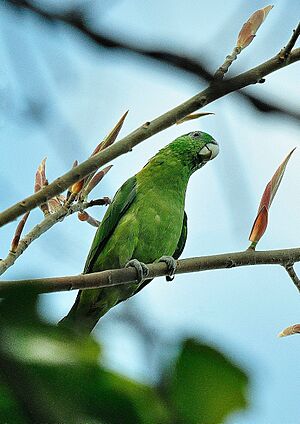Blue-headed racket-tail facts for kids
Quick facts for kids Blue-headed racket-tail |
|
|---|---|
 |
|
| Conservation status | |
| Scientific classification | |
| Genus: |
Prioniturus
|
| Species: |
platenae
|
The blue-headed racket-tail (Prioniturus platenae) is a special type of parrot. It is also known as the Palawan racket-tail. Local people in the Philippines call it kinawihan or 'kilit'. You can find this bird in the western Philippines, especially around Palawan. It lives in wet lowland forests in small groups. This parrot is currently facing threats. Its home is being destroyed, and some are caught for the pet trade.
Contents
What Does the Blue-headed Racket-tail Look Like?
This parrot is about 27–28 centimeters (11 inches) long. Its feathers are mostly green. It has a bright, light blue head. The feathers under its wings are blue, but the top parts are green. Male birds also have a bluish chest. Its beak is bluish-gray, and its eyes are yellowish.
This bird makes many loud squawking sounds. Sometimes, it also makes a more musical sound.
Where Does the Blue-headed Racket-tail Live?
The blue-headed racket-tail lives only on certain islands in the Philippines. These islands include Palawan, Balabac Island, Dumaran Island, Linapacan, Culion, and Busuanga Island.
It prefers to live in lowland forests. You might also see it near farms or sometimes in scrubland and mangroves. It can live at heights of up to 650 meters (about 2,100 feet).
How Does the Blue-headed Racket-tail Behave?
Not much is known about this parrot's daily life. It is usually seen in pairs or small groups. When it flies, it can be very noisy. But when it is eating, it tends to be much quieter.
The blue-headed racket-tail eats many different kinds of nuts and fruits. It often feeds in banana farms. Because of this, some farmers see it as a problem.
Like other racket-tail parrots, it builds its nests inside holes in trees. This means it needs large, old trees to be able to have babies.
Why is the Blue-headed Racket-tail in Danger?
The IUCN (a group that tracks endangered species) has listed this bird as Vulnerable since 1994. This means it is at high risk of becoming endangered. Experts believe there are about 1,500 to 7,000 adult birds left. Their numbers are thought to be going down.
The biggest threat to these parrots is deforestation. This is when forests are cut down. On Palawan, many trees have been cut down quickly. This is due to large mining and logging activities. Mining for a mineral called chromite has destroyed a lot of the bird's home. Cutting down trees illegally also puts the blue-headed racket-tail at risk.
Another threat is people catching them for the pet trade. Most of these birds are caught and sold locally. Very few are sent outside the Palawan area. Sadly, many of these birds do not live long in captivity.
How Can We Help the Blue-headed Racket-tail?
The good news is that the blue-headed racket-tail lives in some protected areas. All of Palawan is technically a game reserve, where hunting is against the law. Even so, some hunting still happens.
Groups like the Katala Foundation are working to help. They have started campaigns and festivals to teach people about protecting these birds.
Here are some ways people are trying to help:
- Studying the remaining forests to find out where the birds live.
- Trying to stop the illegal trade of these birds as pets.
- Supporting plans to make the Puerto Princesa Subterranean River National Park bigger.
- Stopping illegal logging and making sure mining plans do not harm the environment too much.
- Helping farmers find ways to protect their crops without harming the parrots.
- Teaching people that the blue-headed racket-tail is a protected species.


